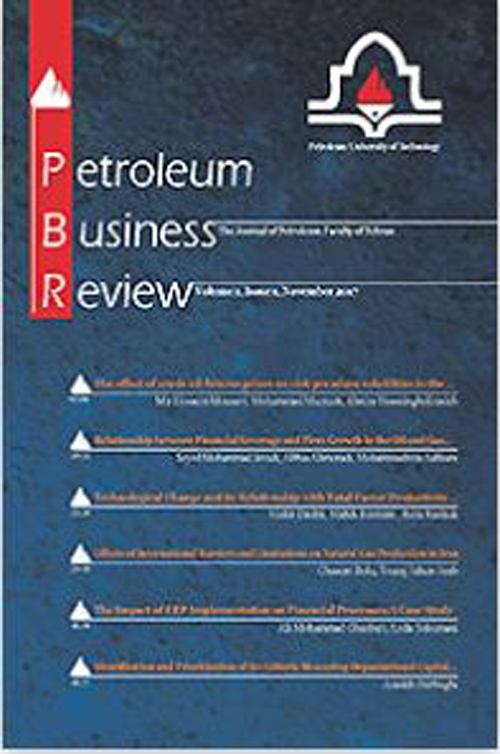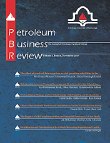فهرست مطالب

Journal of Petroleum Business Review
Volume:5 Issue: 3, Summer 2021
- تاریخ انتشار: 1400/09/14
- تعداد عناوین: 6
-
-
Pages 1-17
This applied research carried out to identify the main and secondary components affecting organizational agility in the University of Petroleum Industry in Iran. In the qualitative section, by reviewing the researches and using a designed questionnaire, 13 hypotheses affecting the organizational agility of the University of Petroleum Industry have been evaluated. The statistical population includes 229 experts working in Ahvaz, Abadan, Tehran and Mahmoudabad colleges. According to the recommended results, out of 42 identified sub-components, 39 components have been confirmed as well as all 13 main hypotheses. The results show that the main effective components with organizational agility followed as organizational agility, human resource value creation, organizational leadership, strategic agility of managers, ICT management, training and empowerment of faculty and staff, establishing knowledge management, strengthening university infrastructure and university culture. It should be noted that SMART PLS software and partial squares technique were used to evaluate the hypotheses verification and recommended solutions.
Keywords: agile organization, Agility, Organizational Agility, PUT, University Agility -
Pages 19-28
Oil and Gas projects as are very complicated. A wide range of risks are included in oil and gas projects and contracts. Different aspects of risks can be addressed in a risk management process which assessment, efficient distribution and allocation of contractual risks are of a high importance. Many researches have studied the Project Risk Management in oil and gas industries with focus on legal and contractual risks aiming to reach to an optimal risk distribution which does not necessarily mean to have a complete contract. In this article with the goal of reviewing contractual risk allocation in Usance finance contracts, a thorough study has been done on related researches and then a complete review has been done on different contracts in Downstream petrochemical projects. Concentration on used risk management mechanisms in both cases and related risks shows severe issues and bugs in both contracts. Some contractual risks are not addressed at all and the case contracts are not balanced in the view of contractual risks distribution.
Keywords: Contract, risk distribution, risk allocation, Usance, Downstream -
Pages 29-41
Organizations enter international competitive markets because of different motivations such as: gaining international fame, long-term growth, increasing profitability, taking advantages of economies of scale, maturing domestic market, the intensity of competition in a domestic market, governmental rules and regulations; but actually, all of the companies aim to export performance improvement. According to the oil industry situation in Iran's vision, the 4th paragraph of general energy policies and, not having a comprehensive model of Iranian oil products export performance, this research could improve and develop this industry in international markets. This research method is phenomenology and statistical society includes export and marketing managers and experts in the oil industry. Non-probable sampling and snowball sampling method was used in this research. Regarding this qualitative research, semi-structured depth interview was used to gather information and 7 deep interviews were done regarding saturated rule. Structure, internal, interpretive and descriptive validity were used in order to Validation; for surveying reliability, revision while coding and surveying by another informed person were used to insure correct coding. After open, axial and selective coding and using Atlas.ti qualitative software, suggested antecedents of Iranian oil products export performance includes: market orientation, company resources, marketing mix, macro environment and items of Iranian oil products export performance includes: financial performance, customer satisfaction and customer retention. Most of the previous studies have focused on positivism and quantitative research methodology while we used the qualitative method in this research.
Keywords: export performance, Market Orientation, Company Resources, Marketing mix, macro environment -
Pages 42-53
The validity of the questionnaire was confirmed using CVR index, as well as exploratory and confirmatory factor analysis while its reliability was evaluated using Cronbach's alpha. Data analysis was performed using Delphi technique, one-sample t-test, and structural equation modeling in SPSS and Lisrel statistical software. Based on the obtained results, four dimensions, 17 components, and 63 indicators were identified for the inter-organizational cooperation management model in oil companies in the Pars Energy Special Economic Zone. Environmental, cultural, organizational, and leadership style dimensions are known as the dimensions of inter-organizational cooperation management in oil companies in the Pars Energy Special Economic Zone. Such factors had the most significance among the identified dimensions of environmental dimension with load factor of 0.99, cultural dimension with load factor of 0.82, organizational dimension with load factor of 0.79 and leadership style dimension load factor of 0.89, respectively, than other dimensions to the concept of inter-organizational cooperation management model in oil companies in the Pars Energy Special Economic Zone. The results indicated that the designing the inter-organizational cooperation management model is divided into four dimensions of environmental, leadership, cultural and organizational dimensions. Environmental dimension includes political, business process, economic, developmental, legal, and technology. Cultural dimension includes the components of conflict management, information sharing, participation, and commitment. Organizational dimension includes the components of philosophy, processes, coordination, and strategy. Leadership style dimension encompasses the components of collaborative leadership, multidisciplinary decision making, and adaptation to management style.
Keywords: Inter-organizational cooperation management, oil companies, Pars Energy Special Economic Zone -
Pages 54-62
Understanding of the interplay between IP rights and competition law in the context of technology transfer in the Iranian oil industry is a point that is discussed in this article. While intellectual property rights enjoy a historic record and appropriate rules in this regard, the competition rights in Iran are taking their initial steps. This imbalance stems from the root of the formation of the legal system of oil in Iran based on contractual frameworks over time. The point to be made in this article is that technology transfer can be expected to take place when the type and purpose of technology transfer have already been defined by legal organizations in relation to the relevant industries. Also, the general targeting in the upstream laws alone cannot meet the legal requirements for the transfer of appropriate technology. Therefore, when even one of the mentioned factors does not exist, one cannot expect constructive interaction in the above-mentioned legal systems.
Keywords: oil law, Technology Transfer Law, Intellectual Property Law -
Pages 62-78
The purpose of this study is to design and explain the model of online advertising with an image-based marketing approach. In this regard, while reviewing the concepts of online advertising, image-based marketing (GIF marketing) and tourism using confirmatory factor analysis and structural equation modeling, we designed and explained the online advertising model with the gif marketing approach in oil and gas’s Industrial tourism hubs of Iran. The research strategy includes a combined qualitative study of content analysis, granded theory and delphi analysis and quantitative study in survey. The study population in the qualitative part includes experts in the field of advertising focusing on the tourism industry and in the quantitative part all tourists are in the oil and gas’s Industrial tourism hubs of Iran. Normal test and confirmatory factor analysis and structural equation modeling test were used to confirm the components and model. The results showed that the components (causal factors, contexts and outputs) of online advertising model with GIF marketing approach in oil and gas’s Industrial tourism hubs are in order of priority. In order to conduct open interviews and coding, 62 indicators were finally extracted. The results of model validation and model overall fit index (GOF), which has a value of 0.794, showed that the overall fit of the model is desirable and as a result, the overall model is valid and approved. Also, in Q2 index, positive numbers showed more than 0.35, which showed the high predictive power of the model.
Keywords: Online advertising, Image based marketing (GIF marketing), Oil, gas industrial tourism


